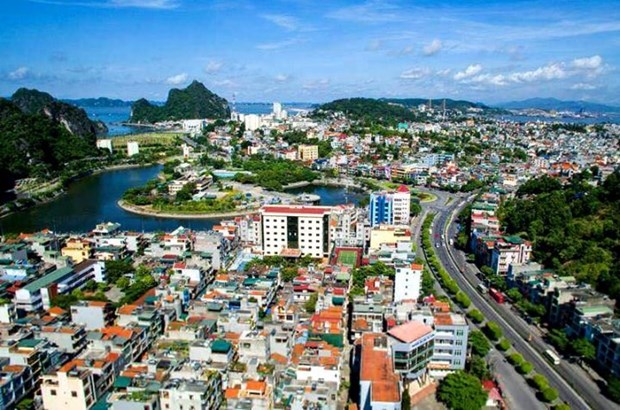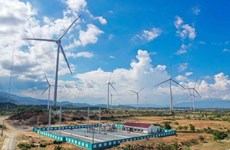Quang Ninh eyes 9.6 percent in GRDP growth in Q2
The northern province of Quang Ninh is taking all-out efforts to achieve a Gross Regional Domestic Product (GRDP) growth rate of 9.6 percent in the second quarter of 2021 and 9.3 percent in the first half of the year.
 A corner of Ha Long city, Quang Ninh province (Photo: VNA)
A corner of Ha Long city, Quang Ninh province (Photo: VNA) Hanoi (VNA) – The northern province of Quang
Ninh is taking all-out efforts to achieve a Gross Regional Domestic Product
(GRDP) growth rate of 9.6 percent in the second quarter of 2021 and 9.3 percent in the first half of the year.
The province sets for its GRDP to grow by 10.1 percent this year.
The services sector is expected to expand 11.5 percent, industry and construction 9.1 percent, and tax revenue from goods 10.2 percent in the second quarter.
A number of measures are being undertaken to revive and boost local tourism, one of the province’s key sectors which has been hit hard by the pandemic, under the “new normal.”
The provincial Department of Industry and Trade has been helping local coal, electricity and cement producers tackle difficulties as the province plans to generate about 12.5 million tonnes of clean coal, 10.5 million kWh of electricity and 879,000 tonnes of cement.
Meanwhile, the Quang Ninh People’s Committee has requested the provincial Economic Zone Authority to actively provide support for a number of foreign investors in developing ready-built factories and storages, liquid bulk terminals and warehouses; and implementing projects.
Quang Ninh targets to attract over 48.34 trillion VND (2.1 billion USD) in investment in local industrial parks and economic zones from April – June. Total State budget revenue is expected to reach 12.23 trillion VND, including over 9.15 trillion VND from domestic collection and nearly 3.15 trillion VND from foreign trade.
The province also plans to disburse 50 percent of public investment plan during the period.
In the first quarter of 2021, Quang Ninh’s GRDP surged 9.02 percent, twice as high as the national average and the second largest among those of provinces in the northern key economic region, only after Hai Phong, despite the fact that the third resurgence of COVID-19 in the province early this year has taken some toll on its economy.
The province managed to contain the COVID-19 outbreak in the shortest possible time. Within only a week from the first local infection being reported in late January, it had completely brought the situation under control, thus minimising the socio-economic impact and stabilising production and business.
The main growth driver during the period was the processing and manufacturing sector, which increased 35.6 percent compared to 20.8 percent in the same period last year. That contributed to a record industrial growth of 8.73 percent in January-March.
Meanwhile, stable growth in agriculture, forestry, and fisheries made up for contractions in other sectors, including tourism, which nosedived almost 50 percent in visitor number and revenue during the period.
Quang Ninh is viewed as a strategic destination in northern Vietnam and an important link in the northern economic growth triangle of Hanoi - Hai Phong - Quang Ninh.
The province possesses major advantages from Van Don district planning to become a multi-sectoral maritime economic zone and entertainment centre with a casino and high-end sea-island tourism and services. It is also a gateway for international trade, creating unique, modern, and high-quality products that are internationally competitive.
Over the past five years, Quang Ninh has experienced high and sustainable growth, with an average annual growth rate of 10.7 percent. Average GRDP per capita is estimated at 6,700 USD in 2020, two times higher than the country’s average figure.
It topped the PCI rankings for the third year in a row in 2019, according to the PCI 2019 report from the Vietnam Chamber of Commerce and Industry.
In addition to the PCI, Quang Ninh also led the country in the PAR Index for three consecutive years, in 2017, 2018, and 2019. The province has also been among the best performers in the SIPAS for many years and rose to the top in 2019.
It has also made great strides forward in improving governance and public administration capacity, moving from 62nd place in 2016 to third last year in Vietnam’s PAPI./.
The province sets for its GRDP to grow by 10.1 percent this year.
The services sector is expected to expand 11.5 percent, industry and construction 9.1 percent, and tax revenue from goods 10.2 percent in the second quarter.
A number of measures are being undertaken to revive and boost local tourism, one of the province’s key sectors which has been hit hard by the pandemic, under the “new normal.”
The provincial Department of Industry and Trade has been helping local coal, electricity and cement producers tackle difficulties as the province plans to generate about 12.5 million tonnes of clean coal, 10.5 million kWh of electricity and 879,000 tonnes of cement.
Meanwhile, the Quang Ninh People’s Committee has requested the provincial Economic Zone Authority to actively provide support for a number of foreign investors in developing ready-built factories and storages, liquid bulk terminals and warehouses; and implementing projects.
Quang Ninh targets to attract over 48.34 trillion VND (2.1 billion USD) in investment in local industrial parks and economic zones from April – June. Total State budget revenue is expected to reach 12.23 trillion VND, including over 9.15 trillion VND from domestic collection and nearly 3.15 trillion VND from foreign trade.
The province also plans to disburse 50 percent of public investment plan during the period.
In the first quarter of 2021, Quang Ninh’s GRDP surged 9.02 percent, twice as high as the national average and the second largest among those of provinces in the northern key economic region, only after Hai Phong, despite the fact that the third resurgence of COVID-19 in the province early this year has taken some toll on its economy.
The province managed to contain the COVID-19 outbreak in the shortest possible time. Within only a week from the first local infection being reported in late January, it had completely brought the situation under control, thus minimising the socio-economic impact and stabilising production and business.
The main growth driver during the period was the processing and manufacturing sector, which increased 35.6 percent compared to 20.8 percent in the same period last year. That contributed to a record industrial growth of 8.73 percent in January-March.
Meanwhile, stable growth in agriculture, forestry, and fisheries made up for contractions in other sectors, including tourism, which nosedived almost 50 percent in visitor number and revenue during the period.
Quang Ninh is viewed as a strategic destination in northern Vietnam and an important link in the northern economic growth triangle of Hanoi - Hai Phong - Quang Ninh.
The province possesses major advantages from Van Don district planning to become a multi-sectoral maritime economic zone and entertainment centre with a casino and high-end sea-island tourism and services. It is also a gateway for international trade, creating unique, modern, and high-quality products that are internationally competitive.
Over the past five years, Quang Ninh has experienced high and sustainable growth, with an average annual growth rate of 10.7 percent. Average GRDP per capita is estimated at 6,700 USD in 2020, two times higher than the country’s average figure.
It topped the PCI rankings for the third year in a row in 2019, according to the PCI 2019 report from the Vietnam Chamber of Commerce and Industry.
In addition to the PCI, Quang Ninh also led the country in the PAR Index for three consecutive years, in 2017, 2018, and 2019. The province has also been among the best performers in the SIPAS for many years and rose to the top in 2019.
It has also made great strides forward in improving governance and public administration capacity, moving from 62nd place in 2016 to third last year in Vietnam’s PAPI./.











